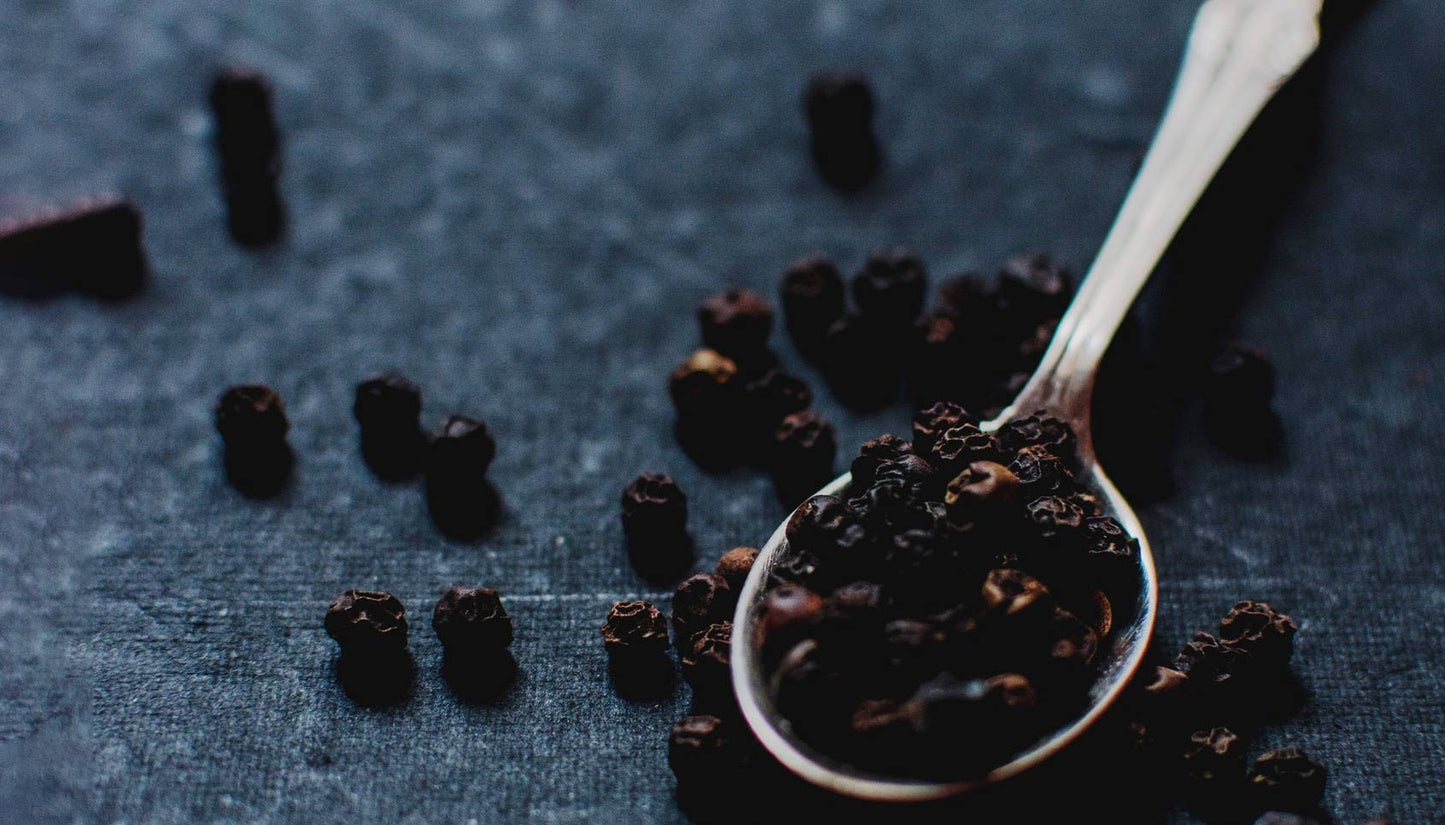We source our chicken from one farm in Leicestershire. The farm is Pasture for Life certified and rears truly free range, outdoor birds.

You might have noticed we use a seaweed, salt and three-pepper mix as the basis of our seasonings and as a standard for our sausages. If you're wondering why we would include seaweed as a seasoning for meats, there are a few very good reasons.
Salt and pepper is a classic seasoning combination in European and western cuisine. The pairing of salt and pepper as table accessories dates back to seventeenth-century French cuisine, when black pepper (unlike herbs such as fines herbes) was considered the only spice that did not overpower the true taste of food.
These days we use salt and pepper automatically without much thought – indeed if a recipe calls for 'seasoning' we all know what that means. But what's the reasoning and history behind this pairing?
Let's start with salt
Salt is used as a universal flavour improver because at low concentrations it will reduce bitterness and increase sweet, sour and umami, which is desirable for sweet recipes. But at higher concentrations it suppresses sweetness and enhances umami, which is good for savoury things.
This historical explanation from The History Vault is a great introduction.
According to records salt was first used in China. In around 450 B.C. a man named Yi Dun started the process of making salt of boiling brine in iron pans until all that remained was a highly sought-after substance: salt. This process spread through Europe about a thousand years later, thanks to the Roman Empire.
Salt was a huge commodity and Roman soldiers were paid partly in salt and their salarium gave way to today’s word for “salary.” The word “salad” also originated from “salt,” and began with the early Romans salting their leafy greens and vegetables. Throughout history salt has been used as a powerful tool to allow governmental monopoly and special taxes. Salt taxes long supported British monarchs and thousands of people were imprisoned for smuggling salt.
Pepper is salt’s more exotic cousin. Black pepper originated in Kerala, India and has been exported from South Asia for about 4,000 years. Pepper was essential seasoning in India (it was often referred to as “black gold”) and was of great value as a traditional medicine, featuring in early medicinal documents such as the Susrutha Samhita. Like salt, pepper was a rare and expensive commodity: the Romans traded in it and peppercorns have been found in ancient Egyptian tombs. It is said that Alaric the Visigoth and Attila the Hun each demanded from Rome a ransom of more than a ton of pepper when they besieged the city in the fifth century.
Pepper was so valuable that a Guild of Pepperers was established in the UK in 1180 and was responsible for maintaining standards for the purity of spices and for the setting of certain weights and measures. Peppercorns were very expensive and were accepted in lieu of money in dowries, taxes and rent, often known as the peppercorn rent, the meaning of which is today very different as it now refers to a very small payment. In Germany there are records of whole towns paying rent with peppercorns.
In big (and wealthy) households, imported pepper was pounded in a pestle and mortar before it was served at the table. As with salt, it is debatable whether pepper was actually used to disguise the flavour of rancid meat as many rich people could afford fresh food, although poorer people may have used it for this purpose once extensive cultivation and trade made it affordable. The Victorian British working classes bought pepper in large quantities, usually in ground form, although it was seen to be dangerous and newspapers of the time were full of scandal stories of pepper being adulterated with other additives.
Yes, pepper wasn’t always so popular. During the Middle Ages and once again in the Renaissance period, pepper was associated with melancholy, and some opted to use sweeter, more sanguine spices. But with the development of modern French cuisine during the Enlightenment, pepper once again became popular as Francois Pierre de la Varenne, France’s first celebrity chef, encouraged readers to season their food with it, alongside a new companion, salt. It would appear that this pairing was favoured as pepper was considered the only spice that complemented salt and that the two did not overpower the true taste of food. In Britain, this practice was quickly adopted and we have followed it ever since.
At The Ethical Butcher we decided to search high and low for the best salt and pepper mix we could put together and make it the staple of our seasonings. We started with salt.
We've chosen to work with Blackthorne Sea Salt, which is air dried in Scotland. This really is the best salt we've ever tasted as well as meeting our ethical standards.

The salt is produced by gently trickling seawater through a huge wooden tower stuffed with blackthorne branches. Blackthorne is a shrubby tree native to the UK. Traditionally it was used in a wealth of remedies including tonics and syrups that ‘cleansed the blood’, aided digestive complaints and eased rheumatism. These tonics and syrups made use of the blackthorn’s bark, flowers and fruit.
As the seawater drips through the thorns, the shoreside wind blows through the tower, evaporating the water and concentrating the brine. This process is manually controlled by the use of 54 wooden taps that are adjusted according to wind speed and temperature.

What does it taste like?
When we first tasted Blackthorne Sea Salt we were amazed at how different something as simple as salt could be. There was a subtle tannic and woody quality from the contact with the thorns, yet the salt was complex, tangy and minerally – and somehow less 'salty'

This pure, unrefined sea salt also carries more minerals than a refined table salt, up 80 different minerals and elements that can be used by the body.
The seaweed connection
So we've explained why we chose to use Blackthorne unrefined sea salt but why would we use seaweed as a seasoning for meats? Truth be told, it came about by accident.
When we developed our burger kits we used a seaweed salt to season the fries and had some left over. One day we were working on a burger blend in our test kitchen, went looking for the salt tub and found the seaweed salt blend. We tried it on a burger and it worked!
Seaweed on meats might sound like a strange pairing but there is no fishiness to this seaweed – just a little of the ocean. We think the subtle flavour enhancement is a definite bonus.
The seaweed we use is from a brand called Mara, a hand-harvested Scottish kombu that coincidentally is based very close to where Blackthorne salt is produced. There must be something in the water!

Kombu is 'known as the superfood of the sea, this kombu kelp is packed with nutrients and fibre. It also is a naturally smooth flavour enhancer, so makes a great alternative to salt. It is pure umami - which translates from Japanese as 'savoury deliciousness'. Add generously into soups, stews and sauces. Mineral-rich, it amazing source of iodine and fibre is one of the best vegetable sources of calcium.'
Japanese cuisine has historically used kombu as a core ingredient in a stock called Dashi. This very simple stock is made by simply adding kombu to water and can be a cold brew, steeped in hot but cooling water or simmered. Often other ingredients are added, for example katsuobushi, which is paper-thin flakes of dried smoked tuna, or shitake mushrooms. Both, along with the kombu, contain the all-important glutamic acid that's responsible for umami, often referred to as the fifth taste.
Umami was first identified by Japanese scientist Dr Kikunae Ikeda in 1908. While he was enjoying a bowl of kelp broth called kombu dashi, he noticed the savoury flavor was distinct from the four basic tastes of sweet, sour, bitter, and salty. He named this additional taste 'umami', which literally means 'essence of deliciousness' in Japanese. Dr Ikeda eventually found the taste of umami was attributed to the amino acid glutamate and its salts, but it wasn't until 2002 that receptors for this taste were discovered on the human tongue.

Image taken from www.ajinomoto.com
Why would we want to add umami?
Umami is one of the key flavours that make meat delicious and although its presence has not been scientifically understood in European and Western cuisine quite like it has in Japan, we certainly consume a lot of foods that have this flavour.
We have favoured umami-rich foods such as anchovies, capers, parmesan cheese, grilled meats, mushrooms (especially shitake) as well as garlic and onions for their taste – and adding other umami ingredients only enhances the flavour further.

Image taken from www.ajinomoto.com
MSG – monosodium glutamate
We can't wrap up a discussion about umami without mentioning the controversial issue of MSG.
MSG is the salt of the amino acid glutamate. It is pure umami and is naturally present in umami rich foods, so why the controversy?
This explanation from Healthline:
MSG got its bad reputation in the 1960s when Chinese-American doctor Robert Ho Man Kwok wrote a letter to the New England Journal of Medicine explaining that he got sick after consuming Chinese food.
He wrote that he believed his symptoms could have resulted from consuming either alcohol, sodium, or MSG. This sparked a host of misinformation about MSG, which was likely related to then-present biases against Chinese immigrants and their cuisine.
The letter led to the designation of Kwok’s symptoms as the “Chinese restaurant syndrome,” which later became the “MSG symptom complex”
Later on, numerous studies backed MSG’s bad reputation, stating that the additive was highly toxic
However, current evidence questions the accuracy of previous research for several reasons, including:
- a lack of adequate control groups
- small sample sizes
- methodological flaws
- a lack of dosage accuracy
- the use of extremely high doses that far exceed those consumed in typical diets
- the administration of MSG via routes with little to no relevance to oral dietary intakes, such as injections
There is a lack of scientific evidence for any kind of toxicity relating to MSG. This study states:
https://www.karger.com/Article/Abstract/494782
The non-essential amino acid glutamate participates in numerous metabolic pathways in the body. It also performs important physiologic functions, which include a sensory role as one of the basic tastes (as monosodium glutamate [MSG]), and a role in neuronal function as the dominant excitatory neurotransmitter in the central nervous system
It could be the case that simple, small amounts found in natural foods are not problematic, but larger quantities cause some problems for sensitive people. We feel that the tiny amount of natural glutamate found in the little kombu we use in a seasoning mix is not of concern, and certainly enhances the taste of our meats!
So that's seaweed and salt covered. Now to talk about the pepper we've chosen.
The peppers
In the same way that meat isn't just meat, pepper is not just pepper. Every black pepper variant has a unique taste, texture and aroma that fit perfectly with different dishes. There are more than 600 varieties of the pepper spice but only a few are generally used in cooking or other applications.
We've been working with the incredibly talented development chef Nick Sandler, known on social media as Nick's Ingredients (give him a follow below).
Nick is the kind of guy who can identify the country of origin of individual ingredients in a complex spice mix just by taste, and has developed some recipes for us on our website. Working with him we developed and tested a mix of three black peppers, each chosen for specific properties.
How we use our pepper mix
So there we have it. We could just use salt and pepper – but then we could also sell just meats.




